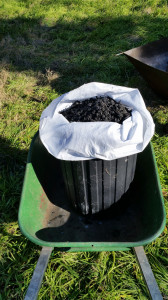HOW TO OFFSET YOUR ELECTRICITY GHG EMISSIONS WITH BIOCHAR
by Brian Lewis - September 11th, 2018.Filed under: Articles.
Where a household seeks to offset the greenhouse gas (GHG) emissions of its electricity consumption on a weekly basis the production and capture of biochar can be used to offset the emissions associated with the generation of that power.
A typical 2 person household consuming 156 kWhr of electricity per week only needs to make 30 kg of biochar to offset the GHG emissions caused by the production of that electricity.
The calculation involves two steps as follows:
Firstly:
The greenhouse gas emissions in tonnes of carbon dioxide equivalent (CO2-ₑ) attributable to the quantity of electricity used may be calculated using the following equation (Ref 1):
Y = Q x EF/1000
Where:
Y is the scope 2 emissions measured in CO2-ₑ tonnes.
Q is the quantity of electricity purchased in kilowatt hours.
EF is the scope 2 emission factor for the State or Territory in which the electricity consumption occurred (in kgCO2-ₑ per kilowatthour).
Scope 2 emissions are those that are physically produced by the burning of fossil fuels (coal, natural gas etc) at a power station. The scope 2 emission factors are state-based, and are the average emission factors for all electricity consumed from the grid in each state.
For example for South Australia in 2018:
EF = 0.51 (2nd lowest after Tasmania which of course has substantial hydro power)
So for a South Australian household purchasing and consuming say 156 kWhr per week (or say 2000 kWhr of electricity from the grid over a typical 90 day billing period) their GHG emissions will be
2000 x 0.51/1000 CO2-ₑ tonnes
= 1.02 CO2-ₑ tonnes.
= 1020 kg of CO2
Secondly:
The molecular weight (MW) of carbon dioxide (CO2) is 12 + (2 x16) = 44; where the MW of carbon is 12 and the MW of oxygen (O2) is 32. Then for every mass unit of carbon that is captured there will be 44/12 or 3.66 mass units of carbon dioxide that have been diverted from the atmosphere. So to offset 1020 kg of CO2 we need to make and capture only 1020/3.66 or 278 kg of Carbon.
A typical biochar making system will be 70 to 80% efficient in terms of carbon as a proportion of dry biochar (depending on feedstock etc) so we need to adjust the value of 278 up to 278/0.75 to obtain the dry weight of biochar typically needed to offset 1020 kg of CO2.
This results in 371 kg of biochar per 1020 kg of CO2.
On a weekly basis this converts to:
29 (say 30) kg of biochar.
Note: The Carbon dioxide equivalent (CO2-ₑ) is derived from estimates of the emissions of carbon dioxide, methane and nitrous oxide produced by the generation of the electricity at the power station.
Ref 1: Australian Government. Department of the Environment and Energy. National Greenhouse Accounts Factors July 2018.



Leave a Reply